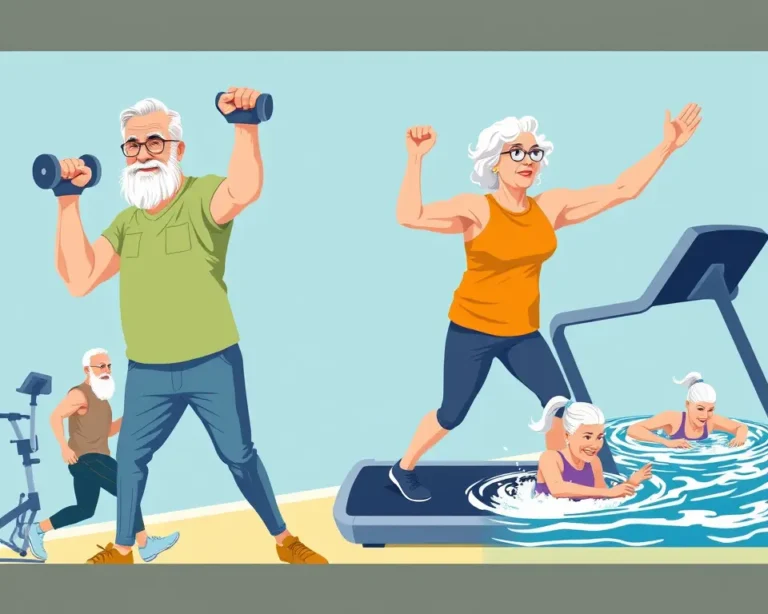The image of aging as a slow decline into frailty is being powerfully challenged by a growing number of seniors who are hitting the gym, pounding the pavement, and proving that age is just a number. These ageless athletes, many in their 70s and 80s, are not only maintaining their physical health but are also inspiring a new generation to embrace exercise as a lifelong pursuit.
The Golden Years, The Steel Resolve
While many people slow down as they age, some seniors are ramping up their fitness routines. These individuals demonstrate that it’s never too late to prioritize physical activity.
Anne and Eric, PureGym members, joined the gym in their 60s and are still enjoying exercising in their 80s. They are staying active and independent for longer thanks to regular exercise.
Dot, a resident at Sunrise Senior Living, turned 100 this year and is known for her energy. She started exercising in her late 80s and can be found working out on stationary bikes or participating in exercise classes.
Kathryn Dettwiller, 77, was encouraged to start exercising 34 years ago by her husband. Despite initially disliking gym class, she has stayed with it.
Why Exercise is the Elixir of Life for Seniors
The benefits of exercise for older adults are extensive and well-documented. Regular physical activity can significantly improve both physical and mental well-being, helping seniors maintain their independence and enjoy a higher quality of life.
Here’s a breakdown of the key advantages:
- Disease Prevention: Exercise helps prevent common diseases such as heart disease, stroke, type 2 diabetes, and some types of cancer. It also improves immune function, which is crucial for seniors whose immune systems may be compromised.
- Fall Prevention: Improved strength and balance through exercise significantly reduce the risk of falls, a major concern for older adults.
- Mental Health Boost: Exercise can alleviate symptoms of anxiety and depression, combat social withdrawal, and improve overall mood.
- Cognitive Function: Physical activity may help reduce the incidence of dementia and improve cognitive abilities like thinking, learning, and decision-making.
- Increased Independence: Maintaining an exercise routine that supports an active lifestyle is vital.
- Improved Cardiovascular Health: Physical activity reduces the risk of cardiovascular disease by 35%.
- Increased Flexibility: Maintaining movement in muscles and joints is essential to decrease discomfort.
- Better Sleep: Regular physical activity can contribute to improved sleep patterns.
Finding Your Fountain of Youth: Getting Started with Exercise
Starting an exercise program can seem daunting, but it doesn’t have to be. The key is to start slowly, gradually increasing the intensity and duration of your activities.
Here are some tips for getting started and staying motivated:
Consult Your Doctor
Before beginning any new exercise program, it’s essential to consult with your doctor, especially if you have any underlying health conditions. They can assess your current fitness level and provide personalized recommendations.
Start Slow and Steady
Begin with low-intensity activities that are appropriate for your current fitness level. Gradually increase the frequency, intensity, and duration of your activities over time.
Choose Activities You Enjoy
The best exercise is the one you’ll actually do. Find activities that you find enjoyable, whether it’s walking, swimming, dancing, gardening, or playing sports.
Make it Social
Group exercise classes, walking groups, or even an “exercise buddy system” can provide social support and increase motivation.
Set Realistic Goals
Don’t try to do too much too soon. Set small, achievable goals and celebrate your progress along the way.
Incorporate Variety
Changing up your routine can prevent boredom and keep you motivated. Try different activities and explore new challenges.
Listen to Your Body
Pay attention to your body’s signals and rest when you need to. Don’t push yourself too hard, especially when you’re just starting out.
Exercise Ideas for Seniors
There are countless ways for seniors to incorporate exercise into their daily routines. Here are a few ideas:
- Walking: A simple yet effective aerobic exercise that can be done anywhere, anytime.
- Swimming: A low-impact activity that’s gentle on the joints.
- Dancing: A fun and social way to get your heart pumping.
- Chair exercises: A great option for those with limited mobility.
- Strength training: Use exercise bands, hand weights, or your own body weight to build muscle.
- Yoga and Tai Chi: These mind-body practices improve balance, flexibility, and strength.
- Gardening: A gentle way to stay active and enjoy the outdoors.
- Golf: Skip the cart and walk the course for a good workout.
Inspiration in Action: Stories of Senior Athletes
The stories of seniors who are defying age through exercise are truly inspiring. They demonstrate that it’s never too late to achieve your fitness goals and live a healthier, more fulfilling life.
Kay Glynn, a 69-year-old, competes in the Senior Olympics in long jump, high jump, and pole vault.
Vera Teachout, 65, and Cheri Hunt, 73, work out several times a week with weights, machines, and cardio to stay strong and flexible in their retirement. They participate in a “Forever Fit” program. Vera started working out when she noticed her golf drives weren’t going as far and she’d get tired doing household chores. Cheri lost 40 pounds and improved her mobility through regular exercise.
Dot, a 100-year-old resident at Sunrise Senior Living, began exercising in her late 80s and can now be found working out on stationary bikes and participating in exercise classes.
Overcoming Obstacles: Addressing Common Concerns
Many seniors face obstacles that can make it challenging to exercise regularly. Here are some common concerns and how to address them:
- Pain: If you experience pain, talk to your doctor or a physical therapist. They can help you find exercises that are safe and effective for your condition.
- Limited mobility: Chair exercises and other modified activities can be a great option for those with limited mobility.
- Lack of motivation: Find an exercise buddy, join a class, or set realistic goals to stay motivated.
- Fear of injury: Start slowly and gradually increase the intensity of your activities to minimize the risk of injury.
- Cost: There are many affordable ways to exercise, such as walking, running, and using home exercise equipment.
The Takeaway: It’s Never Too Late
The message from these ageless athletes is clear: it’s never too late to start exercising and reap the numerous benefits of a physically active lifestyle. By embracing exercise as a lifelong pursuit, seniors can maintain their independence, improve their health, and enjoy a higher quality of life. So, lace up your shoes, find an activity you enjoy, and join the movement of seniors who are defying age and inspiring us all.







